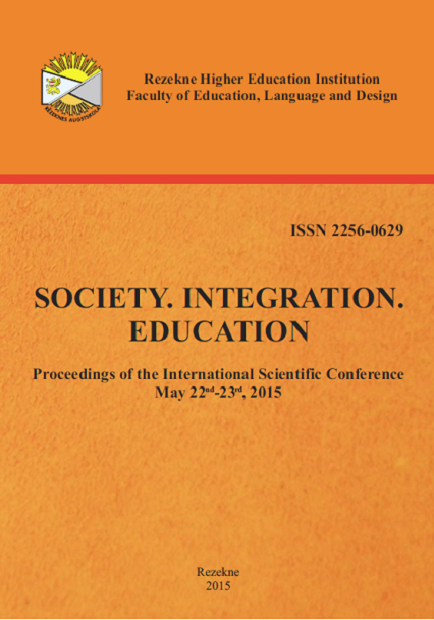Sex and Age Differences in Levels of Anomia of Latvian Inhabitants
DOI:
https://doi.org/10.17770/sie2015vol3.475Keywords:
anomia, meaninglessness, social distrust, social isolationAbstract
Anomia is one of the important factors, which can influence the psychological well-being of individuals. It is especially valuable to determine those socio-demographic groups which can demonstrate the highest levels of anomia. The purpose of the research was to determine whether there are sex and age differences in levels of anomia of Latvian inhabitants. The secondary data from the third European Quality of Life Survey (EQLS) were used. The sample consisted of Latvian inhabitants (n = 1009), aged from 18 to 92 years (male – 34.9%, female – 65.1%). 3 indices and 3 subscales of anomia (Social Distrust, Social Isolation and Meaninglessness) were constructed (Ļevina, Mārtinsone & Kamerāde, 2015a, 2015b). A multivariate analysis of variance was conducted. It was found that there was a significant difference in multidimensional anomia between Latvian inhabitants of different age groups.
References
Cao, L., Zhao, R., Ren, L., & Zhao, J. (2010). Social support and anomie: A multilevel analysis of anomie in Europe and North America. International Journal of Offender Therapy and Comparative Criminology, 54 (4), 625-639.
Craig, G.J. & Baucum, D. (2001). Human Development (9th Edition). New York: Prentice-Hall.
European Quality of Life Survey (EQLS). (2012). Downloaded from http://eurofound.europa.eu/surveys/eqls
Dean, D. (1961). Alienation: Its meaning and measurement. American Sociological Review, 26 (5), 753-758.
Durkheim, É. (1964) [1893]. The Division of Labour in Society. NY: Free Press.
Durkheim, É. (1966) [1951]. Suicide: A Study in Sociology. NY: The Free Press.
Lytkina, E. (2012). From anomie to alienation: An approach towards the measurement of social well-being and deviance. Papers of the IV Russian Sociology Congress. Moscow: Institute of Sociology RAN, Russian Sociological Society, 8227- 8231.
Ļevina, J., Mārtinsone, K., & Kamerāde, D. (2015, a). A model of anomia in the Baltic States. Submitted for publication in The Interdisciplinary Social Sciences Collection.
Ļevina, Mārtinsone, & Kamerāde, (2015, b). Individuālās anomijas modeļi Latvijas populācijā. Iesniegts un akceptēts publicēšanai RSU 2015.gada Zinātniskās konferences tēžu krājumā.
Levina, J., Martinsone, K., Kolesnikova, J., & Perepjolkina, V. (2014). Possibilities of research of anomie in Latvian society. In A. Vētra, A.Vilks (Eds.) 5th International Interdisciplinary Scientific Conference „Society. Health. Welfare”. 2nd Conference of Speech Therapists (Rīga, November 26-28, 2014): Abstracts (p.39). Rīga: RSU.
Merton, R. K. (1962) [1957]. Social Theory and Social Structure. Glencoe, Illinois: Free Press.
Merton, R. K. (1964). Anomie, Anomia, and Social Interaction: Contexts of Deviant Behavior. In M. B. Clinard (Ed.) Anomie and Deviant Behavior: A Discussion and Critique (pp. 213–242). NY: Free Press.
Metha, A. (1972). Existential Frustration and Psychological Anomie within Select College Student Subcultures. Dissertation. Los Angeles: University of Southern California Downloaded from http://digitallibrary.usc.edu/cdm/compoundobject/collection/p15799coll18/id/503255
Olsen, M. (1965). Two categories of political alienation. Social Forces, 47, (3), 288-299.
Richmond, B. D. Mason, R. L., & Smith, V. (1969). Existential Frustration and Anomie. Journal of National Association of Women Deans and Counselors, 32, 136-138.
Seeman, M. (1959). On the meaning of alienation. American Sociological Review, 24 (6), 783-791.
Sev’er, A., Isajiw, W., & Driedger, L. (1993). Anomie as powerlessness: Sorting ethnic group prestige, class, and gender. Canadian Ethnic Studies, 25 (2), 84-99.
Seeman, M. (1982). A Prolegomenon on Empirical Research Regarding Anomie. In S. G. Shoham & A. Grahame (Eds.) Alienation and Anomie Revisited (pp. 121-138). Tel Aviv, Israel: Ramot.
Srole, L. (1956). Social integration and certain corollaries: An exploratory study. American Sociological Review, 21, (6), 709-716.
Zhao, R. & Cao, L. (2010). Social change and anomie: A cross-national study. Social Forces, 88 (3), 1209–1230.
Лыткина, Е. И. (2014). Аномия: новый подход к операционализации классического понятия. XIV Апрельская международная научная конференция по проблемам развития экономики и общества: в 4-х книгах. Книга 4. Отв. ред.: Е. Г. Ясин. М., Издательский дом НИУ ВШЭ, стр. 152-161.






